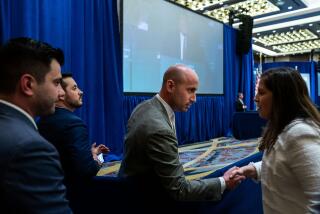Mentor Program Adds Diversity to Corporate Climb
- Share via
When Coopers & Lybrand held its first conference for female partners in June 1996, the relatively small attendance underscored a big problem: Women made up just 8% of the partner population.
About the same time, accountant Ami Milla was feeling torn between seemingly conflicting desires: to have babies, work reduced hours and still advance to partner at the 17,000-person accounting and consulting firm.
Luckily for Milla, her soul-searching dovetailed with top management’s realization that it needed to do something--and quickly--about retaining and promoting key female and minority talent. The solution was C & L 100, a mentoring program that has matched 100 female and minority employees with senior partners who help boost them up the corporate ladder.
“Here was key talent, really crucial in terms of the firm’s success,” said Bob Harper, a partner responsible for human resources in the Los Angeles office. “The mentoring was designed to keep them from slipping away because of neglect.”
At a time when many companies have left career management in the hands of individuals--and job-hopping has become routine--Coopers & Lybrand would seem to be embracing a bygone model.
But many management experts argue that one-on-one mentoring is more crucial than ever precisely because of the dramatic changes in the workplace. Talented female and minority employees often lack the informal networks and savvy that win promotions for white-male colleagues. And, increasingly, employees of all stripes must figure out how to balance careers with complicated family needs.
As companies have grown more multicultural, the image of mentoring has evolved. No longer does it mean a senior guru who taps a rising young (male) star on the shoulder and says, “Follow me. When I retire, you’ll sit in my chair.”
That style “tended to produce clones,” said Gayle L. Holmes, president and chief executive of Menttium Corp., a Minneapolis company that consults on mentoring programs. “Now, the value for companies is to create a diverse pipeline of talent. Cross-gender, cross-race partnerships hold the most potential for learning, change and growth.”
As Ami Milla (her name is pronounced Amy Mee-uh) and her mentor, Steve Hamm, have learned, change and growth cut both ways.
Hamm quickly learned that questions from his “mentee”--the ubiquitous new term for protege--are as likely now to relate to issues of work-and-life balance as they are to nitty-gritty office protocol and career strategy. So, as a top manager, he can simultaneously gain insight into concerns that bedevil employees while dispensing advice to help work through the problems.
Milla, 31, knew of but had not met Hamm, managing partner for the firm’s Los Angeles-area operations, when they were teamed 15 months ago. She was understandably anxious before a get-acquainted lunch at the California Club. But Hamm, her office’s top boss, set a reassuring tone.
“He put me at ease right off the bat,” she said. “He was candid and warm and said no topics were off-limits.”
Confident by nature, Milla, a senior manager who specializes in real estate audits, took him at his word. She has picked up the phone occasionally to ask a burning question, and they have conferred in person half a dozen times. Hamm also makes it a point to ask Milla how things are going when they run into each other at firm functions. Much of the time, the discussion is about her personal life.
“He has enlightened me about the importance of having a balance,” Milla said.
How, she asked at one point, could she placate her husband if she had to work late for a client and could not honor a commitment to be home at a certain hour? Hamm’s practical advice: Don’t commit to being home early on a given day. That way, if you manage to get there, it’s a nice surprise.
The mother of an 18-month-old toddler, Milla, with the firm’s blessing, works a slightly reduced schedule for most of the year (except during the busy tax season). Given her daily 120-mile round-trip commute from Camarillo, she usually feels squeezed for time with her family. Golfing after-hours with colleagues or clients, she told Hamm, would seem a chore. Would that erect barriers to achieving partner status?
No, he told her, it’s not necessarily a part of the partnership track (although Hamm, a devoted sportsman, has played plenty of work-related golf in his time).
Noting that work-life balance has become a priority throughout the firm in the last five years--from Chairman Nick Moore on down--Hamm said he values the opportunity to help someone else avoid the pitfalls of workaholism.
“I don’t want to see people in this organization have to make the personal sacrifices that I felt I had to make,” said Hamm, 50, a divorced father of two grown sons. “For me, it’s an opportunity to relive some of the excitement of a career when you were younger. Some of the things she asks . . . are things I’ve lived through.”
Hamm said Milla has the leeway to juggle clients and family life because of her reputation for getting things done. That enables her to work from home occasionally without riling clients, some of whom know they can call her there in an emergency.
Although Milla has had many informal mentors during her nine years at the firm, her formal relationship with Hamm has been more satisfying. For starters, being selected for the program boosted her morale, since C & L 100 was open only to high achievers with at least three years of management experience. And Hamm’s candor has been instrumental in helping Milla reach a comfort zone. She no longer feels that she must choose between family and career, and she values the loyalty the firm has shown her.
Thanks to a nervy query on her part, she also has a reading on how much longer it is likely to take before she becomes a partner. Hamm said he took the question seriously and consulted several other key partners before giving her an answer.
Hamm, too, has gained personal satisfaction from the relationship, noting: “You get a sense that you make a difference in somebody’s life. There were mistakes I made in my career when I was about her age. You can give a perspective.” He said he considers Milla a friend for life.
Large accounting and consulting firms have a well-deserved reputation for recruiting good people, training them, then watching them depart because they get better offers or feel lost in the shuffle, said David Lewin, a management professor at UCLA’s Anderson School. The renewed emphasis on mentoring marks an important shift in developing “the new cadre of professionals and leaders [a firm] needs,” particularly highly sought-after women and minorities.
About half the recruits at Coopers & Lybrand, for example, are women, yet a small percentage of those employees make partner. Iris Goldfein, the firm’s vice chairwoman of human resources, said progress has been made. After the program’s first full year, Goldfein said, 22% of the proteges have made partner. Women now make up 10% of the firm’s 1,475 partners, with a goal of 30% by 2000. Minority employees, who are much tougher to recruit, account for just 4% of partners.
Despite the program’s early successes, Harper said the firm recognizes that mentoring is not “an elegant solution,” given that it involves linking up individuals whose chemistry might clash. And if the mentor doesn’t buy in to the idea and take seriously the notion of grooming the subordinate, Hamm said, the result could be “exponential ill effects.”
In an attempt to uncover potential disasters, Coopers & Lybrand surveys program participants twice a year. A few proteges have complained that their mentors are geographically too distant to make the relationship work.
Both Milla and Hamm said they have experienced no downsides to their relationship. But Hamm is well aware that the incentive for advancement must still come from the mentee.
“We train our people to be problem solvers,” he said. “With a mentee, you can’t solve her problems. You can’t make anxieties disappear.”
(BEGIN TEXT OF INFOBOX / INFOGRAPHIC)
The Art of Mentoring
Thinking of starting a mentoring program at your company? Here are some tips:
* The company must be specific about the program’s purpose. A program should be geared toward recruiting, developing and retaining talent. Many prospects coming from top schools won’t even consider going to work for a company unless they know they can count on having an in-house coach.
* The “mentees” should have something prominent in common: For example, they should all be new hires or middle managers or engineers who at some point will be running the company. That link makes it easier to match proteges with mentors and implement a program.
* Mentees must be trained to maximize the experience by taking an active role. They must “manage” the mentor and provide the agenda for the relationship.
* The mentor and mentee must share similar values. “It’s easy to get past differences in style and, in fact, it’s useful for the mentee to work with someone with a different style,” said Gayle L. Holmes, president and chief executive of Menttium Corp., a Minneapolis company that consults on mentoring programs. “But you can’t struggle through if your values are very different.”
Source: Menttium Corp.
More to Read
Inside the business of entertainment
The Wide Shot brings you news, analysis and insights on everything from streaming wars to production — and what it all means for the future.
You may occasionally receive promotional content from the Los Angeles Times.











